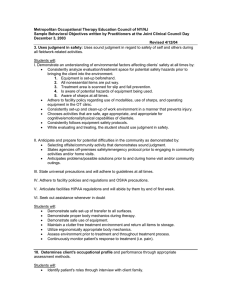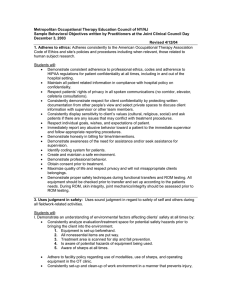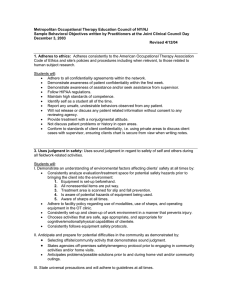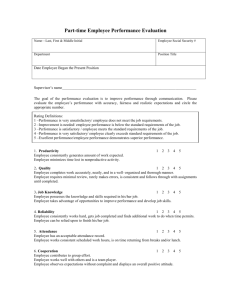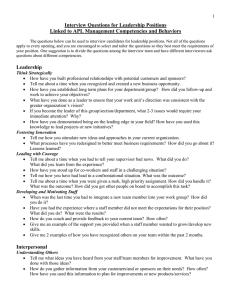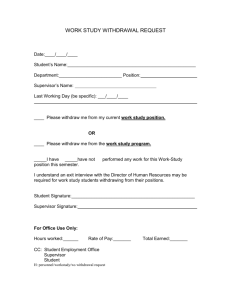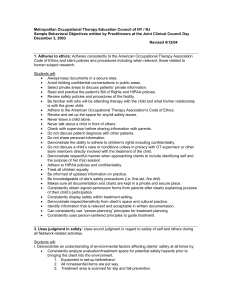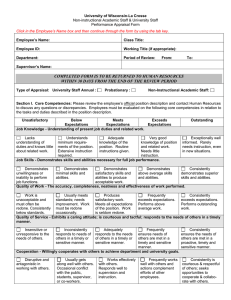Metropolitan Occupational Therapy Education Council of NY/NJ
advertisement
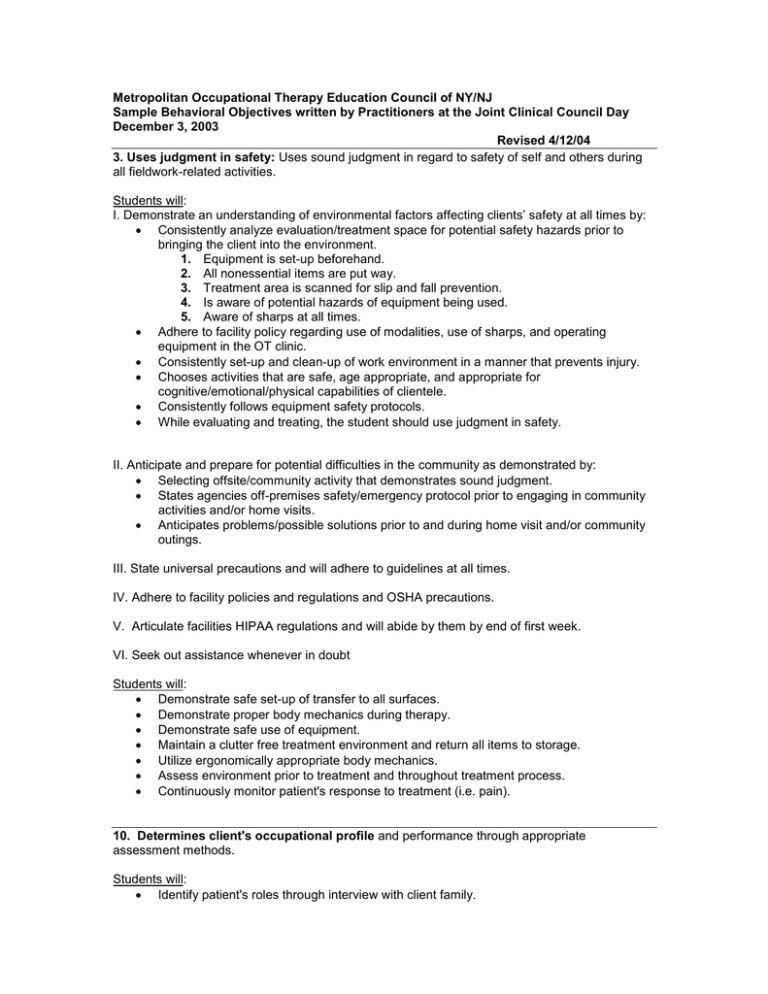
Metropolitan Occupational Therapy Education Council of NY/NJ Sample Behavioral Objectives written by Practitioners at the Joint Clinical Council Day December 3, 2003 Revised 4/12/04 3. Uses judgment in safety: Uses sound judgment in regard to safety of self and others during all fieldwork-related activities. Students will: I. Demonstrate an understanding of environmental factors affecting clients’ safety at all times by: Consistently analyze evaluation/treatment space for potential safety hazards prior to bringing the client into the environment. 1. Equipment is set-up beforehand. 2. All nonessential items are put way. 3. Treatment area is scanned for slip and fall prevention. 4. Is aware of potential hazards of equipment being used. 5. Aware of sharps at all times. Adhere to facility policy regarding use of modalities, use of sharps, and operating equipment in the OT clinic. Consistently set-up and clean-up of work environment in a manner that prevents injury. Chooses activities that are safe, age appropriate, and appropriate for cognitive/emotional/physical capabilities of clientele. Consistently follows equipment safety protocols. While evaluating and treating, the student should use judgment in safety. II. Anticipate and prepare for potential difficulties in the community as demonstrated by: Selecting offsite/community activity that demonstrates sound judgment. States agencies off-premises safety/emergency protocol prior to engaging in community activities and/or home visits. Anticipates problems/possible solutions prior to and during home visit and/or community outings. III. State universal precautions and will adhere to guidelines at all times. IV. Adhere to facility policies and regulations and OSHA precautions. V. Articulate facilities HIPAA regulations and will abide by them by end of first week. VI. Seek out assistance whenever in doubt Students will: Demonstrate safe set-up of transfer to all surfaces. Demonstrate proper body mechanics during therapy. Demonstrate safe use of equipment. Maintain a clutter free treatment environment and return all items to storage. Utilize ergonomically appropriate body mechanics. Assess environment prior to treatment and throughout treatment process. Continuously monitor patient's response to treatment (i.e. pain). 10. Determines client's occupational profile and performance through appropriate assessment methods. Students will: Identify patient's roles through interview with client family. 18. Identify cultural/religious factors through interview. Interview patient, family to gather information of client’s history of occupation, lifestyle and also should read medical charts for medical history and information. Utilize assessment process that respects clients/patients cultural values/physical abilities/interests. Articulates clear and logical rationale for the intervention process. Students will: Demonstrate, during group treatments, recognition of responses from clients and adapt to changes. Explain the expected outcome of individual interventions during treatment session. 32. Clearly and effectively communicates verbally and nonverbally with clients, families, significant others, colleagues, service providers, and the public. Students will: Interact, communicate, and share relevant information with all caretakers, families, and health care professionals. Clearly and effectively communicate verbally by stating clear goals and rationale of treatment to patients, family, and colleagues. Clearly and effectively communicate with patients, families, and team members to explain possible outcomes of OT. Give instructions for the treatment process that are effective, clear, concise, and understandable for each patient’s developmental level and learning style. Respond appropriately to behaviors and questions, give feedback, appropriate cues, and the appropriate amount of assistance to enable patient to participate in activity. Take into account cultural differences and language barriers (providing handout and information in first language). Communicate/demonstrate effective communication skills to meet the needs of each patient. Demonstrate good observational skills when communicating with patients, adjusting instructions based on patient's reactions. Be aware of nonverbal communication and body language of patients, families, and colleagues. Learn to use and develop therapeutic use of self and maintain rapport with patient. Develop boundaries/ability to set appropriate limits with patients. Provide appropriate validation, support, and feedback to patients as needed. Accept constructive feedback and provide input as part of interpersonal communication. Contribute clear, accurate, and concise reports/feedback in team meetings regarding each patient’s progress. Clearly and effectively write progress reports based upon and related to changes in a patient’s progress and needs. 36. Collaborates with supervisor(s) to maximize the learning experience. Students will: Be an active part of supervision and feedback. Take initiative to identify difficulties experienced during evaluation/treatment. Take initiative to present plan of action to improve performance. Use feedback provided to come up with strategies/plans for improvement. Incorporate feedback from supervisor into treatment planning and intervention and discuss outcome. 38. Responds constructively to feedback. Students will: Notice and respond to feedback in a way that would encourage an open exchange of ideas and develop entry-level skills in an effective way. “Hear” and act upon constructive feedback from supervisor by making suggestions as to what could have been or needs to be changed. Demonstrate an active and positive attitude evidenced by body language and use of voice. Verbalize understanding of feedback and develop effective and measurable goals for improvement as needed. Give ideas and respond to feedback on ways to improve by giving examples of what they would do in future situations. Demonstrate change in behavior that shows an understanding of feedback and a movement towards acquiring professional behaviors. Articulate positive feedback and strengths pointed out by supervisor.
